Actually, Marty didn't go Back To The Future: Graphing the train sequence of BTTF3
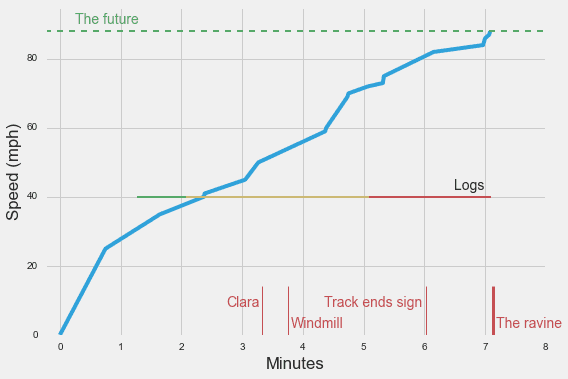
In a hurry? Go straight to the graphs.
The dataset and notebook detailing how this was done are available in the companion repository.
Two weeks ago was Back To The Future Day. October 21st, 2015 is the day Marty and Doc Brown travel to at the beginning of the second movie. The future is now the past. There were worldwide celebrations and jokes, from the Queensland police deploying a hoverboard unit, Universal Pictures releasing a Jaws 19 trailer and even Health Canada issuing an official recall notice of DeLorean DMC-12 because of a flux capacitor defect that could prevent the car from traveling through time.
I love the trilogy and as many people probably did that week, I rewatched the movies. I also wondered if there was any fun BTTF data science project I could do. While watching the climactic sequence at the end of the third movie, I realized that as the steam locomotive pushes the DeLorean down the tracks, we get many data points as to the speed of the DeLorean. Marty is essentially reciting a dataset, all the way from 1885.
That made me ask the 1.21 Giga Watts question: Do they really make it to 88 miles per hour before they run out of tracks?
Doc’s Plan
For those not familiar with the movies, Marty and Doc are trapped in the old West without any gas to power the gasoline engine of the DeLorean, their time-machine. That means they can’t drive it to 88 miles per hour, the speed required to activate the flux capacitor, and travel back to 1985. The plan they come up with is to commandeer a steam locomotive and use it to push the DeLorean to the required speed.
Doc spells out the plan to make it back to the future:
Tomorrow night, Sunday, we’ll load the DeLorean on to the tracks here on the spur right by the old abandoned silver mine. The switch track is where the spur runs off the main line 3 miles into Clayton… Shonash Ravine. The train leaves the station at 8:00 Monday morning. We’ll stop it here, uncouple the cars from the tender, throw the switchtrack, and hijack - borrow the locomotive and use it to push the time machine. According to my calculations we’ll hit 88 miles per hour just before we hit the edge of the ravine, at which point we’ll instantaneously arrive in 1985 and coast safely across the completed bridge.
If you think of it, it’s a shame Doc didn’t equip the DeLorean with Tesla electric motors when he visited 2015. That would have made things easier considering the DeLorean was equipped with a working Mr. Fusion generator in 1885.
The dataset
To assemble the dataset, I simply watched the train sequence and took down each time Marty said the speed, or that we saw it on the speedometer, along with the time in the movie. The tiny dataset is available in the companion repository.
Also, Doc tells us twice in the movie that they have 3 miles of tracks before they hit the ravine. Finally, like Jack Bauer would say, we assume events occur in real-time. This is a critical assumption because I’ll base the distance calculations off this. So if they were to go at a steady 25 miles per hour for one hour in the movie, that would mean that they traveled 25 miles during that period.
Graphing the sequence of events
For simplicity, I assumed a linear progression between each actual data point, meaning we’re assuming a uniform acceleration between data points. The following graph shows the sequence of events as they occur in the movie.
The x-axis represents the number of minutes since the beginning of the train sequence and the y-axis is their speed. The landmarks along the tracks have been labeled in red at the bottom. Finally, the period for which each of Doc’s 3 presto logs burnt have been marked as horizontal lines.
We can see that the whole sequence lasts about 7 minutes and they successfully reach 88 miles per hour just before reaching the ravine, exactly as Doc predicted.
But did they?
How far did they go?
The question we have is about the actual distance it takes them to get to that critical velocity. Since we know at what speed they were going and for how long, we can essentially integrate the time vs speed graph above to get the distance they really traveled.
Doing this gives us the distance vs speed graph that we can use to determine if they really reached 88 miles per hour before having traveled 3 miles. In other words, does the blue speed line get to the green future line before reaching the red ravine line ?
Great Scott! They actually run out of tracks just shy of 70 miles per hour. This means the ravine is actually rightly renamed Eastwood Ravine because Marty does end up at the bottom of it!
Here is another way to look at it:
Can we fix this?
Looking at their acceleration over time sheds some light as to why they got in trouble. Remember we’re assuming a uniform acceleration, meaning that between each actual data point, we assume a linear speed progression between each pair of points.
The following graph shows the acceleration:
The very narrow spikes are when the speedometer is shown on screen and you see the speed go up by 1 mph within 2 seconds. The wider and lower periods are the result of the speedometer not being shown for a while and the speed not having gone up that much in the meantime.
My expectation would have been that as the yellow and especially red logs catch fire, we get a higher and higher acceleration. In reality, acceleration correlates with dramatic moments in the story and with when the speedometer is shown on screen. It’s a movie; I know.
Let’s give Doc a hand and figure out the acceleration his presto logs would have needed to provide in order to make this work. By assuming that we can only influence the acceleration from the point where the green presto log catches fire, we can determine the acceleration we need to get to the right speed in time and derive the following modified distance vs speed graph:
This allows us to plot the new speed curve on the initial graph that showed the sequence of events.
In this scenario, Marty safely goes back to the future after 2 minutes and 8 seconds, a mere 39 seconds after the green log caught fire.
Unfortunately, since Clara came on board exactly when the green log caught fire, she most probably would have made the jump with the locomotive. In the movie, it took her 1 minute and 51 seconds to get to the locomotive’s whistle, so she would not have had time to call for help. Doc, who had to put the presto logs in the firebox while the train was moving, would have had to rush to the DeLorean but it’s possible he would have made it.
In the end…
We’re forced to conclude that Doc’s calculations were off and Marty couldn’t have made it back to the future. The fact that he did may mean that we are currently in a ”time paradox, the results of which could cause a chain reaction that would unravel the very fabric of the space-time continuum and destroy the entire universe.”
But in any case, time travel can be a risky business. As a word of advice: maybe where you’re going, you don’t need roads… but where you came from, always make sure you had enough tracks.
More comments are available on:
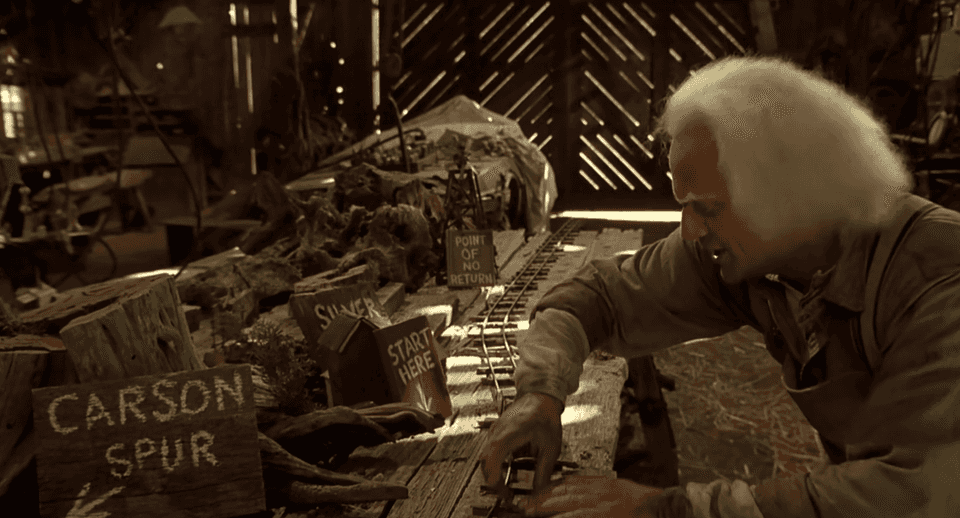

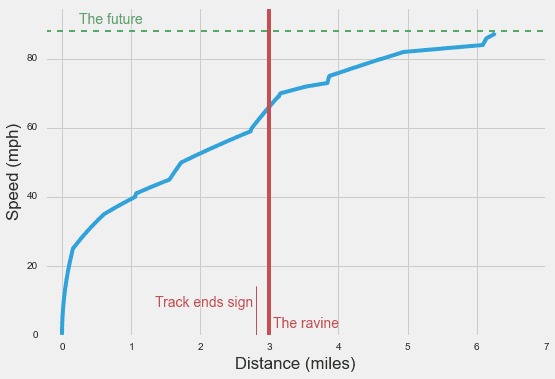
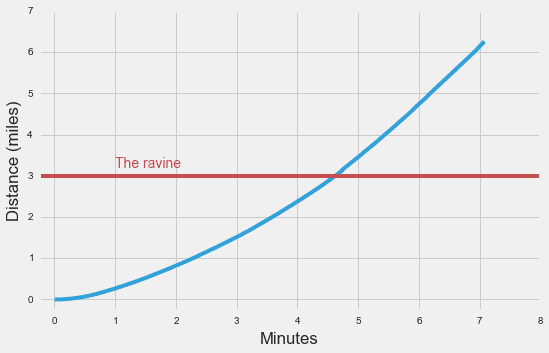
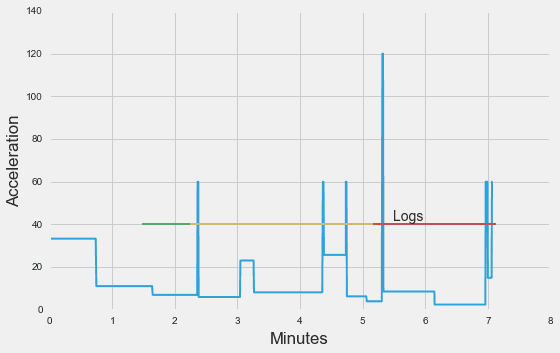
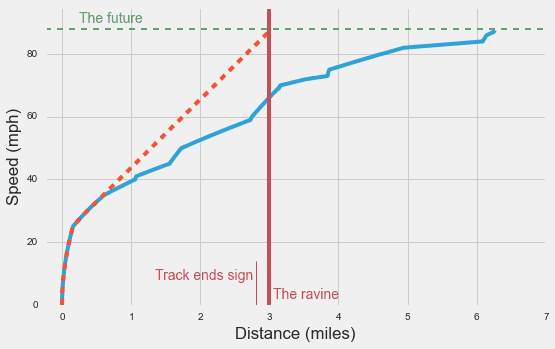
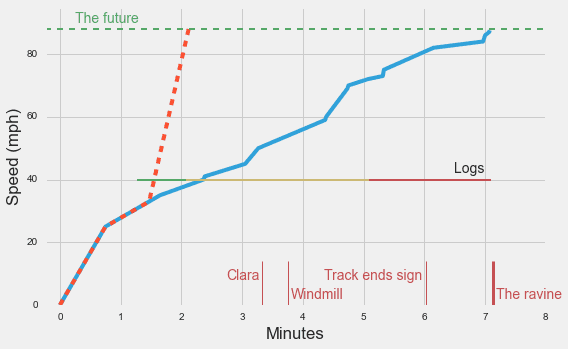
14 thoughts on "Actually, Marty didn't go Back To The Future: Graphing the train sequence of BTTF3"
Commented 2015-11-03 21:28:45
Don't Be So Gullible, McFly. In the first episode, the logistics of Marty turning on a speaker so loud it literally throws him across the room hitting a bookshelf would have knocked him unconscious. The rest of the movies are just a dream while he's in a coma. We're tipped off to that fact as people say "Are you ok? You hit your head." and "You've been asleep for hours."
Commented 2015-11-03 21:39:58
A time paradox....
Maybe that is why the children's books are titled "The Berenstain Bears", but everyone remembers them being titled "The Berenstein Bears" (pronounced bear-en-STEEN).
We all jumped to a very similar, but slightly different future with Marty in BTTF3.
Commented 2015-11-03 21:58:15
Do you know how deep the ravine was?
Could the gravity as he plummeted to his doom have helped nudge him from 70->88mph, or would the drag be too high?
Commented 2015-11-04 00:16:14
@Keilin
You're not thinking 4th dimensionally. Sure he would have hit 88 mph on the way to the bottom of the ravine, but that's where he'd end up in 1985, not safely cruising across the rail bridge.
Commented 2015-11-04 01:07:42
> Finally, like Jack Bauer would say, we assume events occur in real-time.
This isn't a sound assumption. Marty's original trip back to 1985 from 1955 took place over several more minutes than it would have actually taken the DeLorean to get up to 88 MPH. It gets more realistic if only Marty or only the Doc's scenes are counted. No reason that should't hold in part III as well.
Commented 2015-11-04 03:53:38
Watch Fast and Furious 6... Look at the ending hiw far does the runway go
Commented 2015-11-06 10:38:10
@John T: Yup, I've always thought the same thing.
Commented 2015-11-05 14:48:56
BTTF2 fails in the middle. When Biff gives the almanac to himself, he skews the time line. There is no way he could return to the previous time line in 2015 to give the time machine back to Marty and Doc Brown. This is by Doc's own explanation as to why they couldn't go back to their own 1985.
Commented 2017-01-19 19:51:25
Interesting article.
Commented 2016-08-05 02:45:36
Stop Spoiling My Favourite MOVIE! - Yes! - It's A Freakin' Movie Guys!
Commented 2015-11-04 11:37:13
@Dan D.: You're right the original trip back is clearly not in real-time. And the train sequence is very probably not all real time. But I figured it wasn't completely unreasonable to treat it as such because when you watch it, most of it does feel RT and we pretty much see everything that happens in an uninterrupted way, as opposed to the first movie where it really does feel like overlapping shots.
But for the sake of argument, even if the analysis is skewed a bit, it does suggests they were missing a lot of tracks. So if some of the sequence can be considered RT and some of it not, for them to reach the 88 mph in under 3 miles, probably a lot of it would need to be non-RT, which didn't feel right to me based on the way it's presented in the movie.
In any case, thanks for the comment!
Commented 2015-11-04 14:04:52
This is brilliant! Thanks for the informative read and combine your skills with our shared enjoyment for BTTF!
Commented 2015-11-04 18:29:34
But maybe he made it after all, what if after the track ends he begin to fall so extra speed, what is the terminal velocity for a delorean that travel at around 60mph? He made it but jump and land on the bottom of the cliff, that's why the name change and he actually get to the future.
Commented 2015-11-04 19:56:41
You are recording time from your vantage point, the watcher. Clearly the time in the delorean goes slower because of relativistic effects.
(ok, so relativity at that speed doesn't account for much, but just saying).